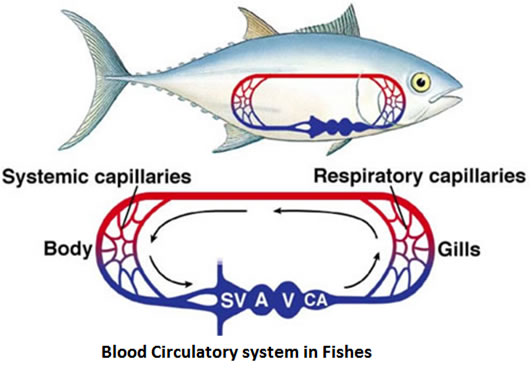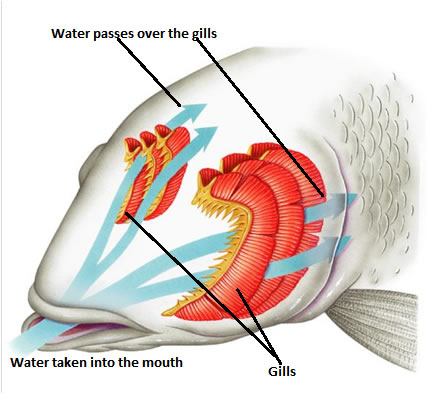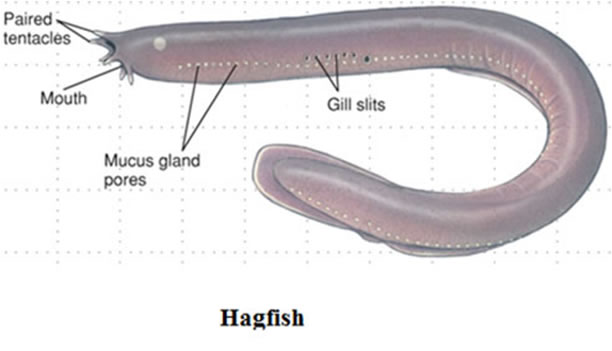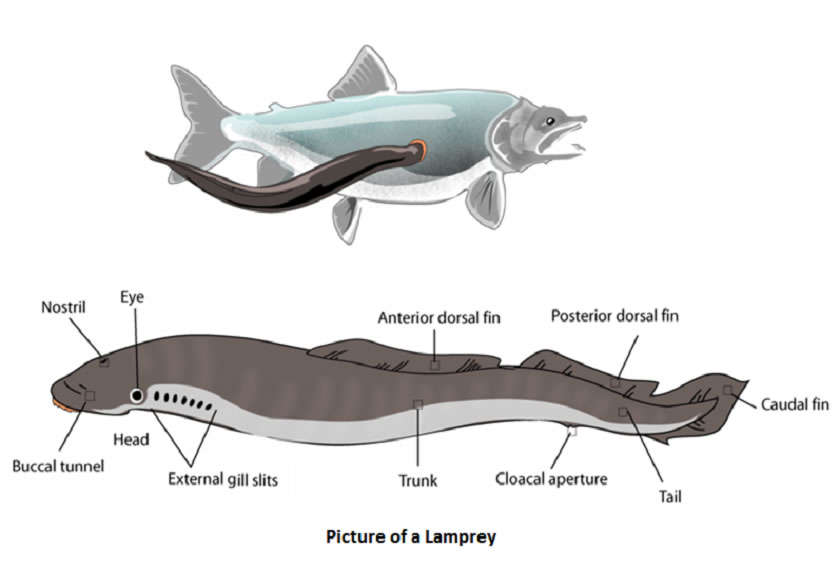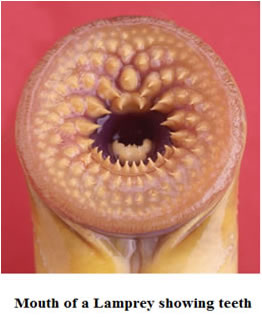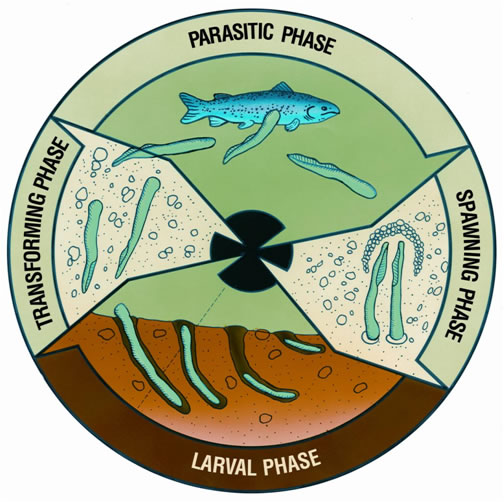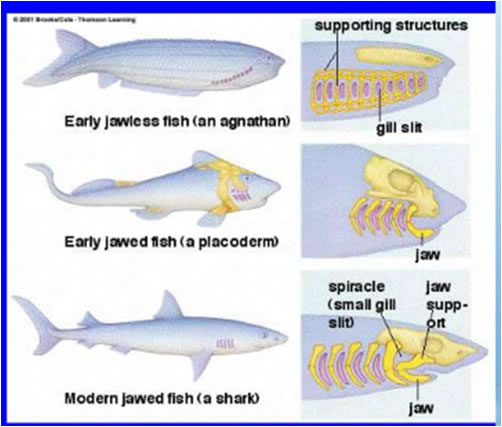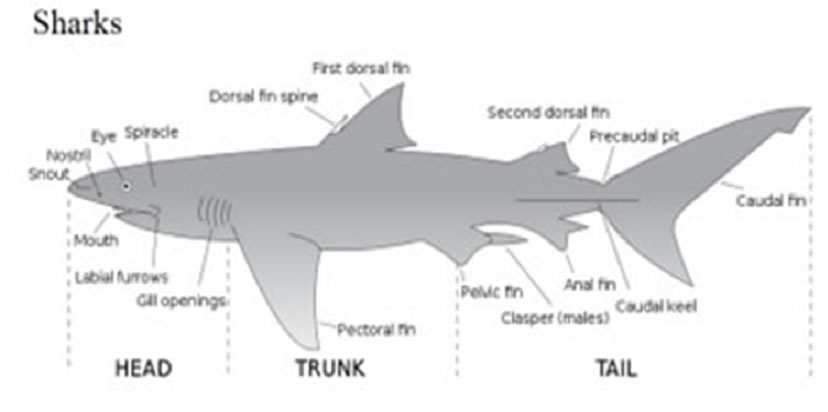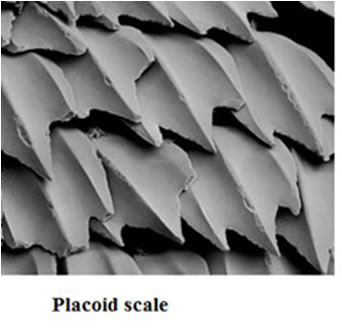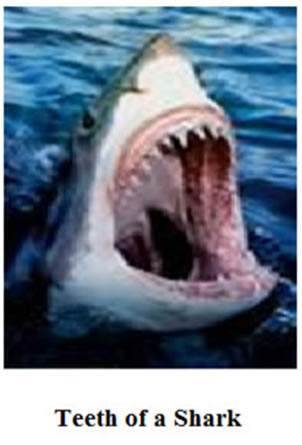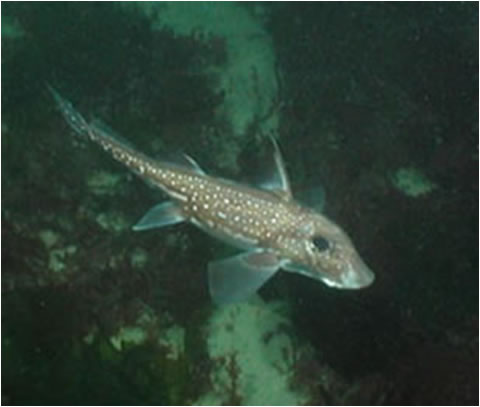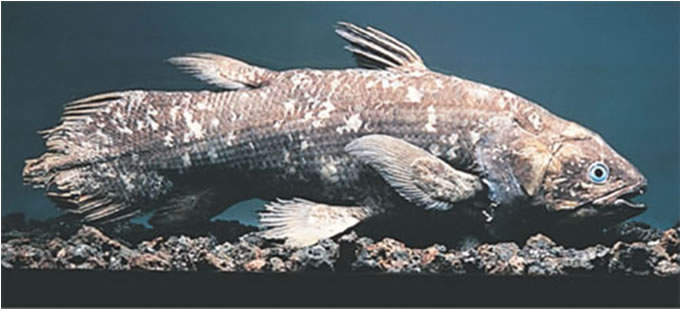DIVERSITY OF CHORDATES
| HOME | CLASS PISCES |
Pisces are found in both marine and fresh water environments.
This class of vertebrates may possess Jaws or not( jawed and jawedless) and paired appendages. The body of Pisces may be covered with scales(Oesteichtyes) or not Lamprey, Hagfishes etc).
Support and movement in pisces is provided by the vertebral Column. The vertebral column may be made up of cartilage or bones. They also use fins for movement.
Control and coordination in Pisces is conducted by well developed nervous system, endocrine system, sensory system. This is reinforced in some groups by the lateral line system, used for sensing and balancing within the environment. Some group of Pisces may possess swim bladder, air filled saclike structure used for balancing in the aquatic environment.
The body of Pisces may be covered with scales( Tilapia, Shark) or mucus (Hagfishes) Fishes have two types of scales covering their bodies. These are: 5.2.5.1. Cycloid scales 5.2.5.2. Ctenoid scales
Cycloid scales have smooth edges.
Figure 1 Cycloid scales
Ctenoid scales have rough edges.
Figure 2 Ctenoid scales
The images below shows (a) Swinm bladder used for buyancy in the aquatic environment. (b) Operrculum, a flat bony structure that covers the gills(organ of respiration) (c). Lateral line system used for balancing and sensing the environment.
Figure 3 Fish swim bladder, operculum and lateral line system
Circulatory system of Pisces comprised of a heart (single auricle and a single ventricle), blood vessels. They exhibit single blood circulation system( a system of blood circulation, whereby the blood passes via the once in a single circulation). The circulatory system of fishes comprised of the heart and dorsal/ventral blood vessels. Fish heart. The heart of the fish comprised of a single atrium and a ventricle. This is shown in the photo on this slide.
Figure 4 Heart of a fish
Fishes exhibit single blood circulatory system. It is a one way system in which the blood passes through the heart once. The blood is passed via the blood vessels from the gills to the ventricle, auricle and then into the body(organs of the body). From the various organs the blood is then transported back to the gills for oxygenation This process is illustrated in the picture below
Figure 5 Fish single circulatory system 5.2.8. Respiration in Pisces Respiration in Pisces may be by use gills, lungs or both. The anatomy of the gill is presented onthe right side of this slide.
Figure 6 Respiration in fishes
The first group of fishes to evolve were the jawless fishes. They possess a heavy bony armor internal skeleton made of cartilage. Most of these group are extinct. They were then replaced by the jaw fishes. The living jawless fishes are the lampreys and hagfish (“Agnathans” - no jaws). First jawed fishes occurred 410 million years ago. Early jawed fishes were later on replaced by the cartilaginous fishes (sharks) and bony fishes, the common fishes we see in our rivers and markets. For example Tilapia, Synodontris.
The class Pisces are classified into two basic Super classes, namely: 5.10.1. Agnatha 5.10.2. Gnathostamata
The word Agnatha a Greek word, consisting of two words, 'A' meaning None and 'gnatha', meaning jaw. Members of this super class are commonly known as Jawless Fishes because they lack jaws. Some of the common Agnatha are the hagfishes and Lampreys.
Some of the basic characteristics of the Agnatha are: Agnathans are strictly marine animals. They are ectotherms. Agnatha lack jaws. They also lack paired fins and gill covers (Hagfishes). The body of hagfishes are covered with mucus. The mucus helps in protecting them. Hagfishes possess gill slits used for feeding and respiration Agnatha lack bony skeleton, posses cartilaginous endoskeleton. They lack paired appendages. Movement is aided by the muscles that surrounds the skeletal system. Agnathans have a complete digestive system, mouth, stomach, intestine. Some Agnathans (Lamprey) have circular sucking mouthparts, they use for parasitizing marine animals. While Hagfishes are scavengers, feeding on decaying flesh.
The Hagfishes are jawless. They are scavengers, living on death organic matter
Figure 7 Agnathan- Hagfish
Example Lamprey The Lampreys are jawless. Lack of jaws forced the Lampreys to lead a parasitic life. They are parasites of vertebrates.
Figure 8 Agnatha- Lamprey
Figure 9 Agnathan- Lamprey mouth
Fertilization in Lamprey is external as it occurs in other fishes. The fertilized egg developes into an Ammocoetes Larval, similar to lancelets( Amphioxus).
Figure 10 Life cycle of Lamprey
Jaws were thought to have evolved from the branchial/vesceral/gill arch of the ancestral Pisces. The ancestral fishes that first developed jaws were the extinct Placoderms
Figure 11 Evolution of jaws in vertebrates
The group of Pisces classifedas Gnathostmes possess jaws. The jaws are thought to have evolved from the skelatal support( pharyngeal clefts/slits) of the ancestral vertebrates. Superclass Gnathostoma. Members of the superclass Gnathostoma are classified into two sub-classes, namely: 5.10.2.1. Sub-Class: Chondrichtyes. 5.10.2.2. Sub-Class: Osteichtyes.
There are approximately 750 species of Chondrichtyes. Chondrichtyes are found mostly in the marine environment. Include sharks, skates, and rays Basic characteristics of the Class Chondrichtyes. Some of the basic characteristics of the Chondrichtyes are: Members live mostly in marine waters and few in fresh waters. Chonrichthyes are called cartilaginous fishes because skeleton is cartilage not bone. They have paired appendages, paired fins. The body of Chondrichtyes are covered with teeth-like scales called Placoid Scales. Chondrichtyes possess several rows of teeth (Not embedded in the jaw). Teeth of Rays and skates are adapted to act as rollers to crush invertebrates and sometimes small fish. Stingrays have whip-like tail with spines and venom glands with which they kill their prey. Some Chondrichtyes have lateral line system. The lateral-line system, allows shark to detect water pressure changes. Electric rays have electric organs on sides of head.
Figure 12 Anatomy of Shark
Figure 13 Placoid sclaes
Figure 14 Mouth of Shark(Chondrichtyes)
Figure 15 Anatomy of Skate
Figure 15 Rattle Fish
Members of this super class are commonly called Bony fishes, because skeletal system is made up of bones not cartilage. Osteichtyes are the diverse of all fish
Some of the basic characteristics of the Osteichtyes are: Oesteichyes are found mostly n fresh water, lakes and rivers. Osteichtyes have skeleton made of bone, not cartilage. They may possess Ray finned, or Lobe finned. The fins are used for movement. The common fins in Osteichtyes are dorsal, Pectoral, Pelvic, Caudal, Anal fins. Osteichtyes homocercal have paired fins Osteichtyes possess scales for protection ( cycloid or ctenoid). They also have bony flap called operculum, allows water to be drawn over gills by fins. Osteichtyes have Swim bladder. Gas content can be manipulated allowing for changes in buoyancy.
Figure 16 Anatomy of a bony fish
The bony fishes are classified into three basic groups, namely: 1. Lobe –finned fish. 2. Lung fish. 3. Ray-finned fish: Lobe finned fishes are extinct ( No surviving spaces now). Ex. coelocanth – discovered off coast of Africa in 1938. They have strong, fleshy pectoral and anal fins which are supported by bones. The coelocanth uses fleshy limbs to “walk” along ocean floor. The lobed-finned fishes are extinct. It is assumed that these fishes are the ancestors of land animals, They gave rise or evolved into the Amphibians, which are the first fairly successful land animals. Thes fishes possess strong skeletal system, comprising of the pelvic girdles that helps them to support themselves on land and move. The picture on the left side of thos sildes presents an extinct lobed0finned fish, called Coelanth.
Figure 18 lobed-finned fish
Lung fishes live in fresh water. Lung fishes have fleshy fins used for locomotion. Lung use gills for respiration. Attimes, the gills are supplemented by air bladder serving as the lungs. Under harsh condition lung fish can lie dormant in mud for up to 10 years, breathing air.
Figure 19 Lung fish
Basic characteristics of ray-finned fishes. Some of the basic characteristics of the ray-finned fishes are: Rayifinned fishes are characterised by the presence of thin, bony spines or “Rays” in their fins. They live in both fresh water and marine water e.g tuna, salmon, tilapia, syndontris etc.
Figure 20 Bony fish
You have learned the following from this module: 1.Pisces are strictly aquatic animals found in both fresh and marine
2.Pisces possess an internal endoskeleton called vertebral Column
3.The body of Pisces may be covered with scales( Tilapia, Shark) or mucus (Hagfishes)
4.Pisces may possess Jaws or not and paired appendages
5.Pisces may use gills, lungs or both for respiration
6.Pisces exhibit single blood circulation system. The blood passes via the heart once.
7.Pisces uses fins for movement
8.Certain group Pisces use lateral line system, to sensing the environment
9.Some group of Pisces may possess swim bladder, air filled saclike structure used for balancing in the aquatic environment
|
| Vertebrata | Amphibia |
2018 Digital Vision Digital Resources



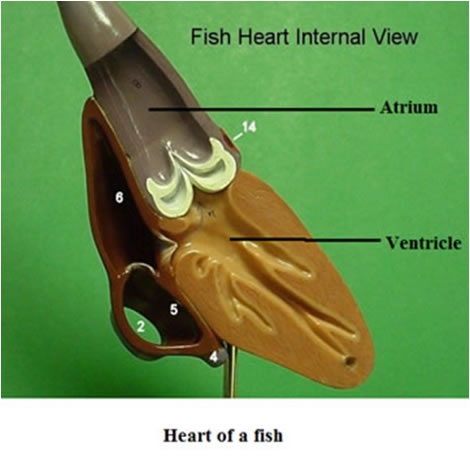 #F
#F